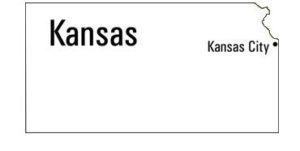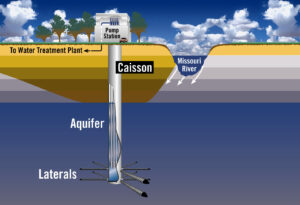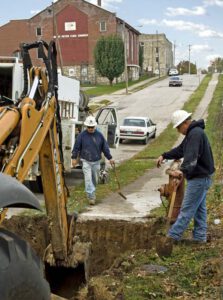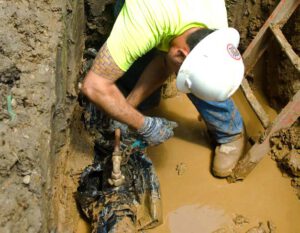The Kansas City Board of Public Utilities (BPU) provides potable retail and wholesale water service to around 55,000 people in Kansas City, Kansas, and neighboring areas. It draws its water from horizontal collector wells in the aquifer below the Missouri River, treats it, and delivers it to customers via around 1,000 miles of water mains. In this interview, James Epp, the BPU’s executive director of water operations, and Steve Green, its director of water distribution, talk to Municipal Water Leader about operating in the age of COVID-19 and the utility’s plans for the future.
 Municipal Water Leader: Please tell us about your backgrounds and how you came to be in your current positions.
Municipal Water Leader: Please tell us about your backgrounds and how you came to be in your current positions.
James Epp: I am from Beatrice, Nebraska, and studied civil engineering at the University of Nebraska. Kansas City is a hub for engineering companies, so my best job opportunities were here. I moved here and accepted a job with an engineering consulting firm. I gained a background in water distribution improvements, hydraulic analysis, and things like that. I started at the BPU as a civil engineer, worked my way up to a director position, and then was appointed acting director of water distribution. After that, I was the full-time water distribution director.
In 2007, I was appointed executive director of water operations. The person who held my current position before me was Don Gray. He became the general manager of the company, so I got the position of executive director of water operations. I also have a master of business administration from the University of Missouri, which has helped me a lot in business and in my position as the chair of our pension fund.
Steve Green: I am from Kansas City, Kansas. I have a bachelor’s degree in business management. I’ve worked for the utility for 32 years. I started in the engineering department, working in mapping, and then quickly moved over to the distribution side. I worked in the field on a crew for about 12 years before taking a supervisory position. I held that position for a few years and then was promoted to superintendent. For the last 14 years, I have been the director of water distribution.
Municipal Water Leader: Please tell us about the BPU and its water services.

James Epp: We provide potable retail water to Kansas City, Kansas, and Edwardsville, Kansas, both of which are in Wyandotte County. We provide wholesale water to supplement the water supply of Bonner Springs, which is in Wyandotte County as well. We also provide wholesale potable water to portions of Leavenworth County and the cities of Baser, Tonganoxie, and Lansing, Kansas. Finally, we service small subdivisions in Johnson County, which is just south of us. Our average demand is about 30 million gallons per day (MGD). Our max days are about 45 MGD and our plant capacity is 72 MGD. We provide service to about 55,000 customers.
Municipal Water Leader: Please tell us about your water treatment and delivery infrastructure.
James Epp: We provide water from source to tap. The source of our water is the Missouri River. We have two horizontal collector wells that go about 100 feet down into a natural sand-and-gravel aquifer. By drawing water from the aquifer instead of directly from the river, we avoid having to treat muddy or high-turbidity water. We take advantage of the natural filtration performed by the sand-and-gravel aquifer. The water coming into the plant is clear and consistent.
We remove iron and manganese from it and perform the conventional treatment process. Then the water goes through a filtration process and a chlorination disinfection process. We store the treated water in reservoirs at our water treatment plant and pump it out of those reservoirs to serve the entire service territory of our system. The transmission mains from the treatment plant range from 24 to 48 inches. We have three primary pump stations that serve our pressure zones, as well as three ground storage reservoirs and three elevated tanks. Our distribution system includes 12-, 8-, 6-, 4-, and 2-inch lines that bring water to our customers.
Steve Green: We have 1,000 miles of water main in our system.
Municipal Water Leader: What is the advantage of drawing water from an aquifer connected to the Missouri River rather than from the river itself?

James Epp: In addition to filtering the water from the river and providing us with water of a consistent quality, it provides a more constant supply. Even if we are experiencing a drought, as long as there’s some water in the river, we’re still in business. The pumps for the collector wells are above the 500-year floodplain level, and there are dual feeds from the electric side of our utility to the station, so it can operate during a flood as well. We can operate it remotely even if we cannot get to the collector wells. We have boats lined up with the fire department so that we can get there and do maintenance during a flood event as well. Also, if there is some sort of contamination or spill on the river, most of it stays on top and does not infiltrate the aquifer. All these factors mean that the horizontal collector wells are a precious resource for our community. They are two of the largest and most efficient in the whole country. Collector well number 1 was completed in 1998, and collector well number 2 was completed in 2004.
Municipal Water Leader: Please tell us about your treatment plant.
James Epp: The treatment plant was put in service in spring 2000, so it’s 20 years old. It still looks brand new. We participate in the Partnership for Safe Drinking Water, which is a voluntary program that aims to exceed U.S. Environmental Protection Agency (EPA) regulations. It is sponsored by six agencies, the main one being the American Water Works Association. The main factor there is finished water turbidity, which is measured in nephelometric turbidity units (NTUs). The EPA standard is 0.3 NTUs, while the partnership standard is 0.1 NTUs. We are the only utility in the states of Kansas and Missouri that participates in this program. A year ago, we received the 10-year director award, which reflects well on our staff and our treatment plant. We’ve also won the gold and platinum awards from the Association of Metropolitan Water Agencies for utility excellence. Those are two things we take a lot of pride in.
Municipal Water Leader: Kansas City, Kansas, directly adjoins Kansas City, Missouri, meaning that your service area abuts both municipal and state boundaries. Is your system at all interconnected with that of Kansas City, Missouri, and are any difficulties posed by your location on the border of multiple jurisdictions?
James Epp: We have interconnections with the system of Kansas City, Missouri, but they really don’t benefit our water system. They’re more for the
benefit of Kansas City, Missouri. They also provide a backup to the University of Kansas Hospital, which is located right on the state line. Our major interconnects are with WaterOne, the public water utility in Johnson County, just south of Wyandotte County. We have three interconnects with it. One is rated at about 6 MGD and the others are rated at about 25 MGD. Since our average day is 30 MGD, it’s more than sufficient. We tested the 6 MGD interconnection once, during the flood of 1993. WaterOne has used it two or three times in order to get water from us.
As for the situation with multiple jurisdictions, it doesn’t present any issues. The Kansas Department of Health and Environment knows that there are interconnects, and we notify it if we have to use them. We really only use our major interconnects within Kansas. To the best of my knowledge, during my career here, the interconnects between our system and that of Kansas City, Missouri, have never been used.
Municipal Water Leader: How has the COVID-19 pandemic affected your operations?
James Epp: It’s had an effect on revenue, because there was a period where we couldn’t shut people off. Disconnects are still being debated nationwide. When you can’t shut off people, revenues come in slower. We’ve had to make some adjustments to our capital budget and delay some projects.
As far as staffing, we’ve staggered the shifts of water distribution workers. We wear masks and practice social distancing. Our treatment plant operators are extremely important because they need a class 4 certification to operate the plant. We don’t have many employees with that credential, so we have to protect those operators. We’ve adjusted the shifts so that there’s only one operator working per shift. That way, if one person gets infected with COVID-19, the other operators will not be exposed. So far, none of our operators has been infected.
In total, only two or three BPU staff members have tested positive for COVID-19. In most cases, they were infected off the job. We only had one case of an employee likely infecting another employee on the job. We’re doing a lot to protect our employees. We’re all still coming to work. Steve has separated his clerks into individual offices. We’re getting by on the operations side. When someone tests positive, you have to send anybody who has been in contact with them to get tested and possibly to quarantine. It’s had an effect, but it has not disrupted our 24/7 operations.
Steve Green: It helped that the management team moved pretty quickly to cut back on unnecessary expenses and to put some capital improvement projects on hold.

Municipal Water Leader: What are your other top issues?
James Epp: As far as future projects go, we want to maintain our main replacement program. We have a lot of old 2- and 4-inch mains, some galvanized and some cast iron. We also are utilizing new technology for leak detection. Going forward, we need to build a new 7-million-gallon ground reservoir to provide backup supply for the University of Kansas hospital and our industrial customers. We want to put in a new transmission main to provide backup to the western part of our service territory and our wholesale business. We want to maintain our valve and hydrant inspection program; our service replacement program; and our meter replacement program, particularly for large meters. Small meters maintain their accuracy for several years, but large meters do not. Those meters are basically our cash register, so it’s important that we do that.
If you visited our Newman Water Treatment Plant, you would think it was brand new, but in fact it is 20 years old. We need to step up our program for replacing parts at the plant, especially electrical components.
Another thing that is important is succession planning. The current BPU employees all have many years of experience, but many of us are also approaching retirement. I preach to my staff about the importance of preparing the people who are going to replace you. We don’t want to leave without people in place to continue providing safe, good-quality drinking water to our customers in the most efficient manner possible. That is our mission statement.
Steve Green: One of our biggest goals is to have a good succession plan for water operations and to train and educate our younger employees so that they are ready to take over operations and continue to deliver the high-quality water that the BPU provides to this community.
Municipal Water Leader: What is your vision for the future?
James Epp: We want to continue to uphold our mission statement, to meet and exceed all state and federal water quality standards, and to provide the best service we can.
James Epp is the executive director of water operations at the Kansas City Board of Public Utilities. He can be contacted at jepp@bpu.com or
(913) 573‑9830.
Steve Green is the director of water distribution at the Kansas City Board of Public Utilities. He can be contacted at sgreen@bpu.com or
(913) 573‑9630. For more information about the BPU, visit www.bpu.com.
